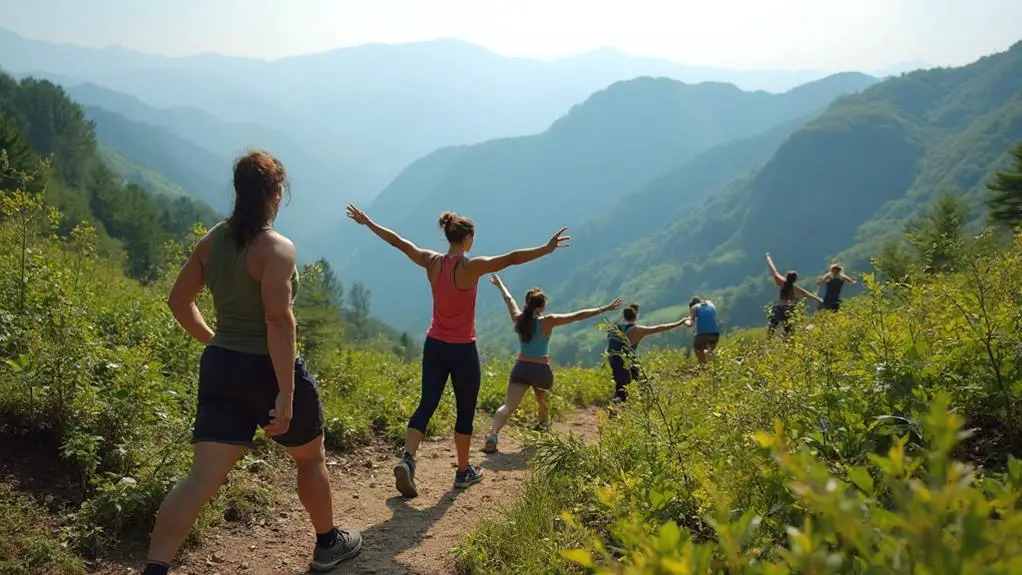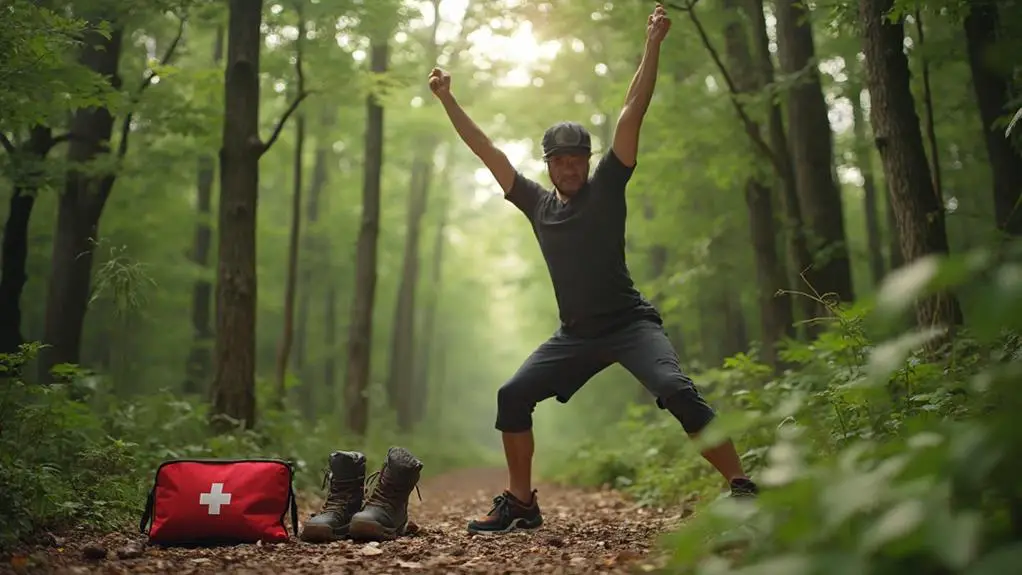An ideal stretching routine for hikers involves a combination of dynamic and static stretches focusing on key muscle groups like the quadriceps, hamstrings, calves, hips, and ankles. Begin with dynamic stretches—such as leg swings and walking lunges—to activate muscles and increase blood flow before your hike. After hiking, incorporate static stretches like the hamstring and couch stretches, holding each for 30-60 seconds to enhance muscle recovery and flexibility. This regimen not only reduces the risk of common injuries like sprains and strains but also promotes effective recovery. Discover strategies tailored to maintain peak hiking performance and injury prevention.
Key Takeaways
- Engage in dynamic stretches like leg swings pre-hike to activate muscles and improve flexibility.
- Incorporate static stretches post-hike, such as hamstring stretches, to enhance recovery and flexibility.
- Use foam rolling to alleviate muscle tightness and complement stretching routines.
- Perform controlled breathing and a 5-10 minute brisk walk to prime the body before stretches.
- Minimize injury risks by targeting key muscle groups: hamstrings, quads, calves, hips, and back.
Importance of Stretching
Stretching plays an essential role in enhancing a hiker's performance and safety. Contrary to common stretching myths and misconceptions, proper stretching is vital for maintaining flexibility, improving movement efficiency, and reducing injury risk during hikes. Anatomical evidence supports that a consistent stretching routine, both pre- and post-hike, markedly alleviates muscle soreness and enhances recovery.
Dynamic stretching before hiking, such as leg swings or arm circles, prepares muscles by boosting blood flow and joint mobility, vital for strenuous activities like hiking.
Furthermore, static stretching post-hike aids in muscle relaxation by targeting key areas frequently stressed during hiking, including the hips, legs, and back. Techniques like hamstring stretches or calf extensions can relieve discomfort and prevent the tightness commonly associated with prolonged physical exertion. Regularly incorporating these specific stretches can enhance overall physical endurance, allowing hikers to tackle challenging trails with improved ease and reduced fatigue.
Addressing stretching myths, it's important to understand that incorrect stretching techniques or neglecting stretching altogether can lead to suboptimal hiking performance and potential injuries. Emphasizing anatomically accurate and evidence-based stretching practices guarantees hikers are well-prepared and resilient, promoting a safer and more enjoyable hiking experience.
Benefits for Hikers

Understanding the numerous advantages that stretching provides can greatly enhance a hiker's experience. Stretching is essential for improving flexibility, which is fundamental for maneuvering the varied and often challenging terrains encountered on hikes. Enhanced flexibility allows for efficient movement, reducing energy expenditure and allowing hikers to tackle steep inclines or rocky paths with greater ease. This efficiency is one of the primary hiking benefits that prevents fatigue and supports prolonged activity.
From an anatomical perspective, regular stretching is significant in reducing the risk of injuries such as sprains and strains. By preparing muscles for the physical demands of hiking, stretching guarantees that muscles are more resilient against sudden movements or uneven ground.
In addition, stretching is integral to muscle health, as it increases blood flow, delivering crucial nutrients and oxygen to muscle tissues. This promotes overall muscle function and repair.
Post-hike recovery is another noteworthy benefit, with stretching assisting in alleviating muscle soreness and expediting muscle repair processes. Additionally, consistent stretching contributes to better joint mobility and reduced stiffness, elements that are essential for a comfortable and pain-free hiking experience.
Consequently, incorporating stretching into routine practices offers extensive benefits, fortifying both the short- and long-term health of hikers.
Types of Stretching
While starting a hike, incorporating the right types of stretching into your routine is essential for best performance and injury prevention. Employing both static techniques and dynamic strategies can effectively prepare and recover the body for the physical demands of hiking.
Dynamic stretching, which should precede the hike, involves controlled, movement-based exercises that activate muscles, increase blood circulation, and improve joint mobility. These dynamic strategies are vital to priming the body for the physical challenges of the trail.
Movements such as leg swings, arm circles, and walking lunges engage the hips, hamstrings, quadriceps, and calves—key muscle groups utilized during hiking. By incorporating dynamic stretches, hikers can reduce muscle stiffness and enhance their overall performance.
Post-hike, static stretching is advised to aid in recovery and flexibility improvement. Static techniques involve holding stretches for 30-60 seconds, allowing the muscles to lengthen effectively. This method targets specific areas that endure tension, such as the calves and quadriceps, promoting relaxation and reducing the risk of injury.
Additionally, foam rolling complements these stretching practices by offering self-myofascial release, which alleviates muscle tightness.
Implementing consistent stretching routines, combining both dynamic and static approaches, optimizes hiker resilience and minimizes injury risk.
Static vs. Dynamic Stretches

Distinguishing between static and dynamic stretches is integral for constructing an effective stretching routine tailored to hikers. Static stretching, which involves holding a stretch for 30-60 seconds, is primarily beneficial post-hike. This form of stretching aids in recovery by enhancing flexibility and extending muscle length. Conversely, dynamic stretching is characterized by movement, actively engaging muscles to increase blood flow. Dynamic stretching is ideal pre-hike as it prepares the body by improving range of motion and reducing injury risk.
Stretching Comparison
| Aspect | Static Stretching | Dynamic Stretching |
|---|---|---|
| Timing | Post-hike | Pre-hike |
| Duration | Hold for 30-60 seconds | Continuous movement |
| Primary Benefit | Flexibility & Recovery | Enhanced Performance & Blood Flow |
| Target Muscle Groups | General | Hips, Legs, Back |
| Injury Prevention | Aids recovery, not immediately | Reduces risk during activity |
Both static and dynamic stretching are pivotal in a hiker's regimen. Dynamic stretches should be emphasized before initiating trails to engage key muscle groups like the hips, legs, and back, ensuring ideal performance and safety. Meanwhile, static stretching post-hike facilitates effective muscle recovery and flexibility enhancement, completing a holistic approach to hiking fitness.
Effective Warm-Up Stretches
To optimize hiking performance and reduce injury risk, it is imperative to incorporate effective warm-up stretches that target essential pre-hike movements and key joint mobilization.
Emphasizing dynamic stretches such as the World's Greatest Stretch and Leg Swing can enhance blood circulation to critical areas like the ankles, hips, and mid/upper back, thereby preparing the body for the demands of the trail.
Additionally, integrating exercises such as jumping jacks or high knees for 5-10 minutes can further raise heart rate and muscle readiness, ensuring a thorough warm-up routine.
Essential Pre-Hike Movements
For hikers aiming to optimize their performance and reduce the risk of injury, engaging in a series of essential pre-hike movements is essential. Initiating with controlled pre-hike breathing can enhance oxygen delivery to muscles, setting the foundation for effective warm-up exercises.
Timing is vital; dedicating 5-10 minutes to a brisk walk or light jog boosts the heart rate and primes the body for more dynamic stretches.
Dynamic stretches such as high knees and leg swings effectively target and prepare key muscle groups, particularly the quadriceps, hamstrings, and hip flexors. These movements increase blood flow and improve flexibility, important for a strenuous hike.
In addition, the Knee to Wall Stretch is recommended to enhance ankle mobility, a critical factor in safely traversing uneven terrain by increasing the range of motion in the ankle joint.
Incorporating the World's Greatest Stretch into your routine can greatly loosen the hips and mid-back, areas often strained during hiking. This multifaceted stretch addresses flexibility and muscle coordination, ensuring readiness for the trail.
Consistently performing these warm-up stretches not only decreases the likelihood of common hiking injuries but also promotes overall hiking performance, making them indispensable for any hiking regimen.
Key Joint Mobilization Techniques
When starting on a hike, the importance of key joint mobilization techniques cannot be overstated, as they play a critical role in preparing the body for the physical demands of trail navigation.
An effective warm-up routine should incorporate specific stretch techniques to enhance joint mobility, thereby reducing the risk of injury. The Knee to Wall Stretch is an essential component, as it greatly improves ankle range of motion, important for managing uneven terrain. Proper ankle flexibility allows for smoother shifts and prevents undue stress on the joints during prolonged hikes.
Another significant technique is the World's Greatest Stretch, which targets the hips and mid-back. This stretch enhances overall flexibility and minimizes stiffness, which is particularly beneficial for lengthy hikes.
Additionally, dynamic Leg Swings activate the hamstrings and hip flexors, ensuring these muscle groups are adequately prepared for hiking demands. Furthermore, incorporating hip rotations can further promote hip flexibility, necessary for maintaining balance and stability on rugged trails.
A consistent 5-10 minute warm-up routine focused on these joint mobilization techniques not only enhances hiking performance but also greatly mitigates the risk of injury, ensuring a safer and more enjoyable hiking experience.
Post-Hike Stretching Routine

A thorough post-hike stretching routine is important for alleviating muscle tightness and promoting effective recovery. Implementing post hike strategies as part of your recovery rituals can greatly enhance flexibility and reduce post-exertion stiffness. Key stretches should be held for 30-60 seconds to maximize benefits.
Begin with the Hamstring Stretch, which targets the posterior chain and helps relieve soreness from extended uphill or downhill hiking. This is essential for maintaining ideal muscle length and preventing imbalances.
The Couch Stretch is recommended to address quadriceps tightness. This stretch is particularly beneficial after prolonged periods of knee flexion during descents, effectively restoring muscle elasticity.
The Rag Doll Pose serves as a thorough stretch for the back, facilitating relaxation and blood flow to the spinal muscles, which often bear the brunt of backpack-induced strain.
In addition to these, incorporating ankle stretches is critical. Perform 10 repetitions of moving the feet up and down and making circles, which enhances joint mobility and reduces soreness.
Consistent post-hike stretching not only promotes blood flow and nutrient delivery but also expedites recovery times. By adhering to these scientifically-backed strategies, hikers can guarantee readiness for future adventures.
Common Hiking Injuries

While post-hike stretching plays an essential role in recovery, understanding common hiking injuries is equally important for preventing long-term issues.
Ankle sprains are prevalent among hikers due to uneven terrain, resulting in ligament damage, swelling, and pain. These injuries can lead to chronic instability if not adequately addressed. Observational studies suggest that strengthening exercises for the peroneal muscles and proprioceptive training may reduce recurrence rates.
Muscle strains typically occur from overexertion or abrupt movements, especially when carrying heavy backpacks or traversing challenging trails. The hamstrings and quadriceps are particularly susceptible. Conditioning these muscles through resistance training can enhance endurance and reduce the risk of strains.
Knee pain often arises when descending steep slopes or traversing rocky paths. Patellar tendinitis, commonly known as "hiker's knee," can develop from repetitive stress. Biomechanical assessments indicate that strengthening the quadriceps and improving flexibility can help mitigate these issues.
Back pain is frequently a consequence of improper posture or carrying an excessively heavy backpack, leading to lower back muscle strain. Core strengthening exercises and ergonomic backpack adjustments are recommended to prevent discomfort.
Shin splints, characterized by pain along the shins, often reflect overuse or insufficient warm-up. Gradual mileage increases and proper footwear selection can help prevent this condition.
Specific Stretching Exercises

Incorporating specific stretching exercises into a hiker's routine is essential for targeting key muscle groups and enhancing overall flexibility and recovery.
Important stretches such as the Standing Quad Stretch, Hamstring Stretch, and Calf Stretch focus on the quadriceps, hamstrings, and calf muscles, respectively, addressing common areas of tension.
Additionally, the Hip Flexor Stretch and Ankle Circles are significant for improving hip mobility and ankle stability, both of which are critical for traversing uneven hiking terrain.
Essential Stretches Overview
For hikers seeking to enhance performance and prevent injury, an extensive stretching routine is fundamental. Incorporating structured stretching techniques facilitates muscle recovery, guaranteeing hikers maintain peak flexibility and resilience on the trail. Here, we outline several evidence-based stretches that are indispensable for hikers.
| Stretch Name | Muscles Targeted | Duration |
|---|---|---|
| Quadriceps Stretch | Front thighs (quadriceps) | 30 seconds |
| Hamstring Stretch | Hamstrings | 30 seconds |
| Calf Stretch | Calf muscles, ankles | 30 seconds |
| Hip Flexor Stretch | Hip flexors | 30 seconds |
The Quadriceps Stretch is essential for relieving tension in the front thighs, which can become tight after prolonged hiking. Similarly, the Hamstring Stretch targets the posterior thigh muscles, significant for maintaining balanced muscle function. The Calf Stretch, performed in a lunge, not only stretches the calf muscles but also enhances ankle flexibility, crucial for traversing uneven terrain. Meanwhile, the Hip Flexor Stretch is instrumental in reducing hip tension, promoting a full range of motion.
Incorporating these anatomically-focused stretches into a routine helps hikers prepare their bodies for the demands of hiking while mitigating the risk of injury. Regular practice guarantees effective muscle recovery, maintaining strength and flexibility for continued hiking adventures.
Target Key Muscle Groups
Building on the foundational understanding of essential stretches, it becomes vital to focus on specific stretching exercises that target key muscle groups for hikers.
Prioritizing hamstring flexibility, a seated stretch where one leg is extended forward and the torso reaches towards the toes should be held for 30 seconds. This stretch mitigates tightness accrued from arduous trails.
Meanwhile, hip flexor activation is important, especially for hikers who often experience tightness from prolonged sitting or inclines. A kneeling stretch, where the hips are pushed forward with a straight back, held for 30 seconds on each side, effectively counters this stiffness.
Quadriceps tension, common from extensive hiking, can be alleviated by standing on one leg, pulling the opposite heel to the glutes, and maintaining this for 30 seconds.
Similarly, calf soreness—a frequent complaint after lengthy hikes—can be addressed through a calf stretch. By lunging forward while keeping the back leg straight and pressing the heel to the ground for 30 seconds, hikers can prevent post-hike discomfort.
Lastly, upper body tension from carrying a backpack can be minimized through shoulder rolls and tricep stretches, each held for up to 30 seconds, completing a thorough stretching routine.
Enhance Flexibility and Recovery
Ideal flexibility-recovery routines are vital for hikers seeking to enhance their performance and reduce injury risk. Regular stretching is a proven flexibility technique that optimizes movement efficiency, essential for effective hiking. Specific stretching exercises target key muscle groups, such as the quadriceps and hamstrings, which are heavily utilized during hikes. The Standing Quad Stretch and Hamstring Stretch are two recommended exercises that, when held for 30-60 seconds, increase muscle elasticity and promote an enhanced range of motion, thereby minimizing strain risks.
Incorporating recovery strategies like post-hike stretches is equally important. The Runner's Lunge and Ankle Stretches specifically alleviate muscle tightness and improve circulation, aiding in faster recovery. This consistent practice not only enhances flexibility but also diminishes post-hike soreness, contributing to long-term improvement.
Here is a concise guide for stretching:
| Stretching Exercise | Target Area |
|---|---|
| Standing Quad Stretch | Quadriceps |
| Hamstring Stretch | Hamstrings |
| Runner's Lunge | Hip Flexors |
| Ankle Stretches | Ankles, Calves |
| Full Body Stretch | Overall Flexibility |
Stretching Techniques

Dynamic and static stretching techniques form the cornerstone of an effective stretching routine for hikers. Incorporating dynamic stretches such as leg swings and the World's Greatest Stretch before a hike is essential for increasing blood flow and preparing muscles for the demands of trail activity. These exercises should be performed with a focus on controlled breathing techniques and mental focus to enhance the neuromuscular connection, ensuring muscles are primed for movement.
Dynamic stretching should prioritize targeted areas such as hips, calves, and the lower back, which are integral to hiking performance and injury prevention.
Post-hike, static stretching should be emphasized to aid in muscle recovery and flexibility enhancement. Holding static stretches, like the hamstring and calf stretch, for 30-60 seconds helps in elongating muscle fibers and relieving tension accumulated during the hike.
Additionally, the use of foam rolling techniques on major muscle groups, particularly the quads and hamstrings, can greatly relieve tightness and improve muscle elasticity. Consistency in these stretching practices is essential.
Avoiding Stretching Mistakes

Stretching, a fundamental component of any hiker's routine, must be executed with care to prevent common mistakes that can compromise its benefits. One prevalent stretching myth is that speed enhances efficacy. Rushing through stretches limits their capacity to improve flexibility and reduce injury risk. Instead, stretches should be held for 30-60 seconds, allowing muscles to adapt and elongate properly.
Equally important is the often-misunderstood concept of pain in stretching. Contrary to common misconceptions, stretching should not be painful but should induce a sensation of mild discomfort, signaling effective muscle engagement without risk of damage.
To further optimize stretching, avoid neglecting a proper warm-up. Cold muscles are more susceptible to strains, emphasizing the significance of light activity such as walking or jogging to prepare the body. Additionally, it's essential to address imbalances by targeting all key muscle groups, particularly the hips and legs, which are heavily utilized in hiking.
- Hold each stretch for 30-60 seconds to maximize effectiveness.
- Warm up with light activities like walking to reduce injury risk.
- Engage all key muscle groups, especially hips and legs, to prevent imbalances.
Consistency in your stretching regimen is critical to maintaining flexibility and reducing injury risk.
Tips for Effective Stretching

For many, the key to accessing the full benefits of a stretching routine lies in the implementation of effective techniques. A foundational step is initiating your routine with a warm-up consisting of light cardiovascular activity for 5-10 minutes. This primes the muscles, enhancing their elasticity, and considerably contributes to injury prevention.
During stretching, focus on breath control; inhaling deeply and exhaling slowly can assist in muscle relaxation and improved stretch quality. Holding each stretch for 30-60 seconds is essential to allow muscle fibers sufficient time to lengthen properly. This promotes flexibility and aids in preventing injuries.
Utilize props like water bottles or trees for support, especially during balance-intensive stretches, to maintain stability and correct form, further reducing the risk of strain. Incorporating both static and dynamic stretches targets vital areas such as the hips, legs, and upper body, important for hikers.
This diversity enhances overall mobility and prepares the musculoskeletal system for the demands of the trail. Consistent stretching, particularly before and after hiking sessions, integrates these benefits into daily practice, fostering long-term flexibility and efficient recovery.
Adhering to these guidelines guarantees a robust and effective stretching routine.
Stretching Frequency and Duration

To enhance hiking performance and recovery, it is important to establish a consistent stretching routine tailored to individual needs. Engaging in dynamic stretches for 5-10 minutes before hiking primes the muscles, enhancing preparedness for the physical demands of the trail.
Similarly, dedicating 5-10 minutes to static stretches post-hike facilitates recovery by alleviating muscle tightness. For each stretch, a hold of 30-60 seconds is recommended to maximize flexibility and prevent injury.
Incorporating stretching into your daily regimen is essential, especially before and after hikes. This proactive approach not only maintains muscle health but also greatly reduces the risk of injuries.
It's important to make duration adjustments based on personal comfort and the intensity of one's hiking activities.
- Dynamic stretching: 5-10 minutes pre-hike effectively warms up muscles.
- Static stretching: 5-10 minutes post-hike aids in reducing muscle tightness.
- Hold each stretch: 30-60 seconds for best benefits.
Furthermore, adjusting the stretching frequency is important; it should align with your hiking schedule and personal comfort levels. A tailored stretching routine will guarantee that you are not only prepared for each hike but also recovered and ready for the next adventure.
Utilizing Stretching Props

Enhancing flexibility and stability during stretching routines can be effectively achieved through the strategic use of props. Selecting appropriate props such as a yoga strap or resistance band offers significant benefits, including improved range of motion and targeted muscle engagement. These tools facilitate deeper stretches by providing necessary support, thereby enhancing stability and flexibility.
For hikers, incorporating these props into routines can prevent injury by ensuring proper form and alignment.
In addition to traditional props, everyday items can serve as effective aids. A water bottle, for instance, can function as a makeshift prop to enhance balance during standing stretches, allowing hikers to focus on their posture without compromising stability. Similarly, a sturdy tree or bench can be utilized for support in exercises like the quad stretch, promoting alignment and reducing fall risk.
Foam rollers are highly recommended for their dual function as a stretching prop and a tool for self-myofascial release, effectively alleviating muscle tightness and enhancing circulation.
This prop selection is integral to hiking integration, offering significant flexibility improvement and stability enhancement. By incorporating these equipment recommendations, hikers can achieve stretching variations tailored to their anatomical needs, ultimately aiding in injury prevention.
Additional Resources and Support

Engaging with additional resources and support is essential for hikers looking to optimize their stretching routines and prevent injuries. Online communities serve as invaluable support networks where hikers can exchange tips, advice, and insights on stretching and injury prevention. Participating in these communities fosters shared learning and enhances understanding of hiking techniques and flexibility training.
Structured programs and educational resources, such as blogs and podcasts, offer evidence-based guidance on creating effective stretching routines. These resources provide ongoing education about the latest research and best practices in injury prevention, ensuring hikers remain informed and prepared.
Accessing structured training programs tailored for hikers can greatly enhance physical fitness, improving both flexibility and strength, while adhering to safety protocols.
Personalized guidance through trainer consultations is another critical aspect. Trainers specializing in hiking preparation can design tailored stretching routines that address individual needs and goals, ensuring a safe and effective approach to both stretching and hiking activities. This personalized attention helps target specific concerns, promoting injury prevention through precise anatomical focus.
- Join online communities: Exchange tips and insights with experienced hikers.
- Access educational resources: Stay updated on safe stretching techniques.
- Seek trainer consultations: Receive personalized guidance tailored to your needs.
Frequently Asked Questions
How Do You Stretch to Prevent Injuries?
Injury prevention during physical activities can be improved through dynamic stretching, which enhances muscle readiness and blood circulation. Focus on movements like leg swings and walking lunges to target key muscle groups, thereby minimizing potential strains and injuries.
Should You Stretch Before or After Hiking?
Dynamic stretching before hiking is essential to enhance joint mobility and warm up muscles, reducing injury risk. Post-hike, static stretching aids muscle recovery and relaxation by alleviating stiffness, focusing on strained areas like hamstrings and quadriceps.
Does Stretching Before Activity Prevent Injury?
Evidence supports that dynamic stretching before physical activity enhances injury prevention by preparing muscles and joints for exertion. Anatomically, it increases blood flow, flexibility, and mobility, reducing the risk of strains and sprains during demanding activities such as hiking.
What Is the Best Stretch Before Walking?
Dynamic stretches like leg swings activate muscles essential for walking, enhancing flexibility and blood flow. Follow with static stretches, targeting calves and hamstrings, held for 30-60 seconds to improve range of motion and reduce injury risk.
Conclusion
To sum up, implementing a structured stretching routine is essential for hikers to enhance flexibility, prevent injuries, and optimize performance on the trail. Emphasis on both static and dynamic stretching, tailored to the specific demands of hiking, provides thorough musculoskeletal benefits. Effective warm-up exercises, appropriate stretching frequency and duration, and the use of props can greatly contribute to the overall efficacy of the routine. Access to additional resources and professional guidance further supports hikers in achieving their fitness and safety goals.